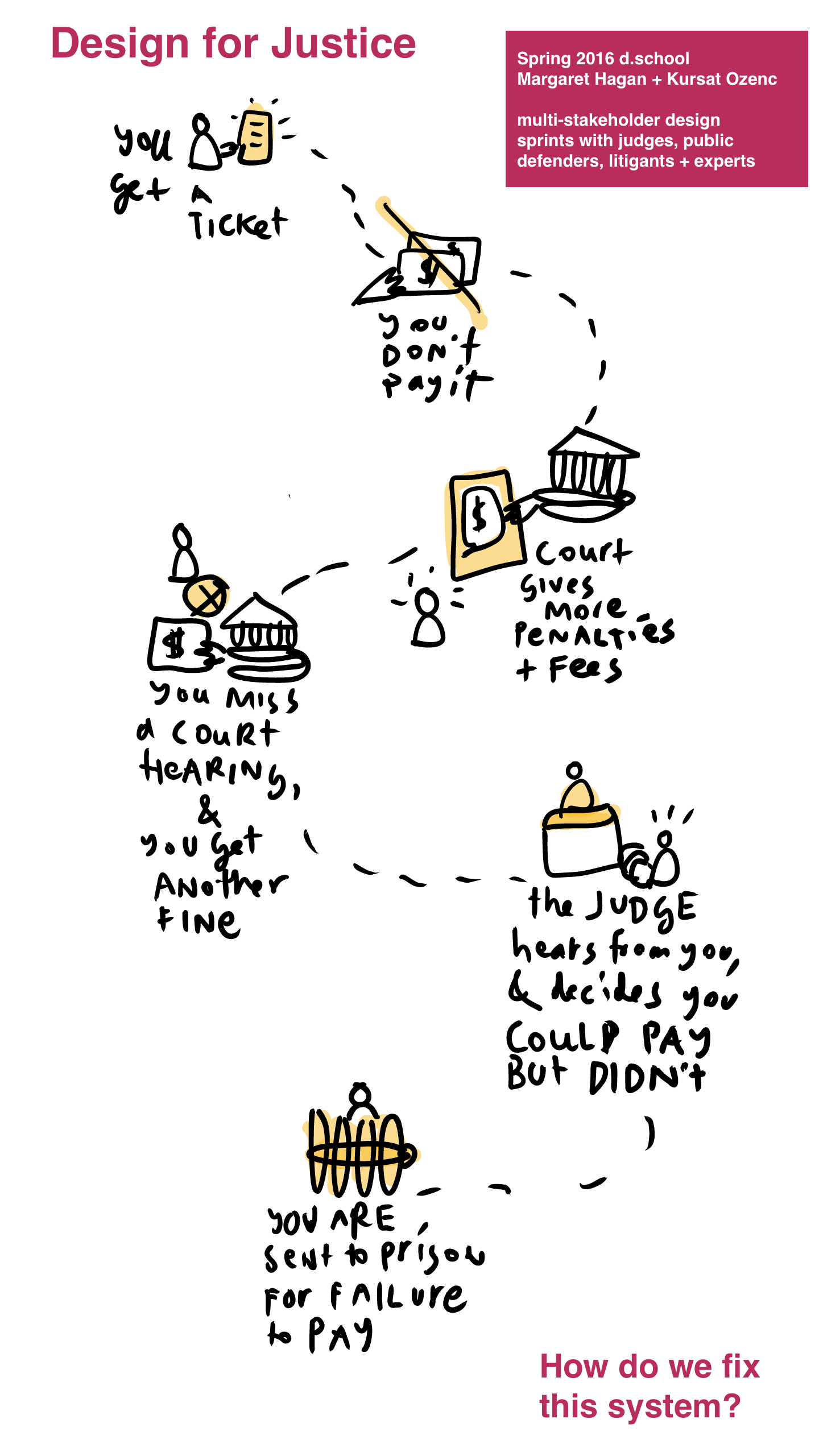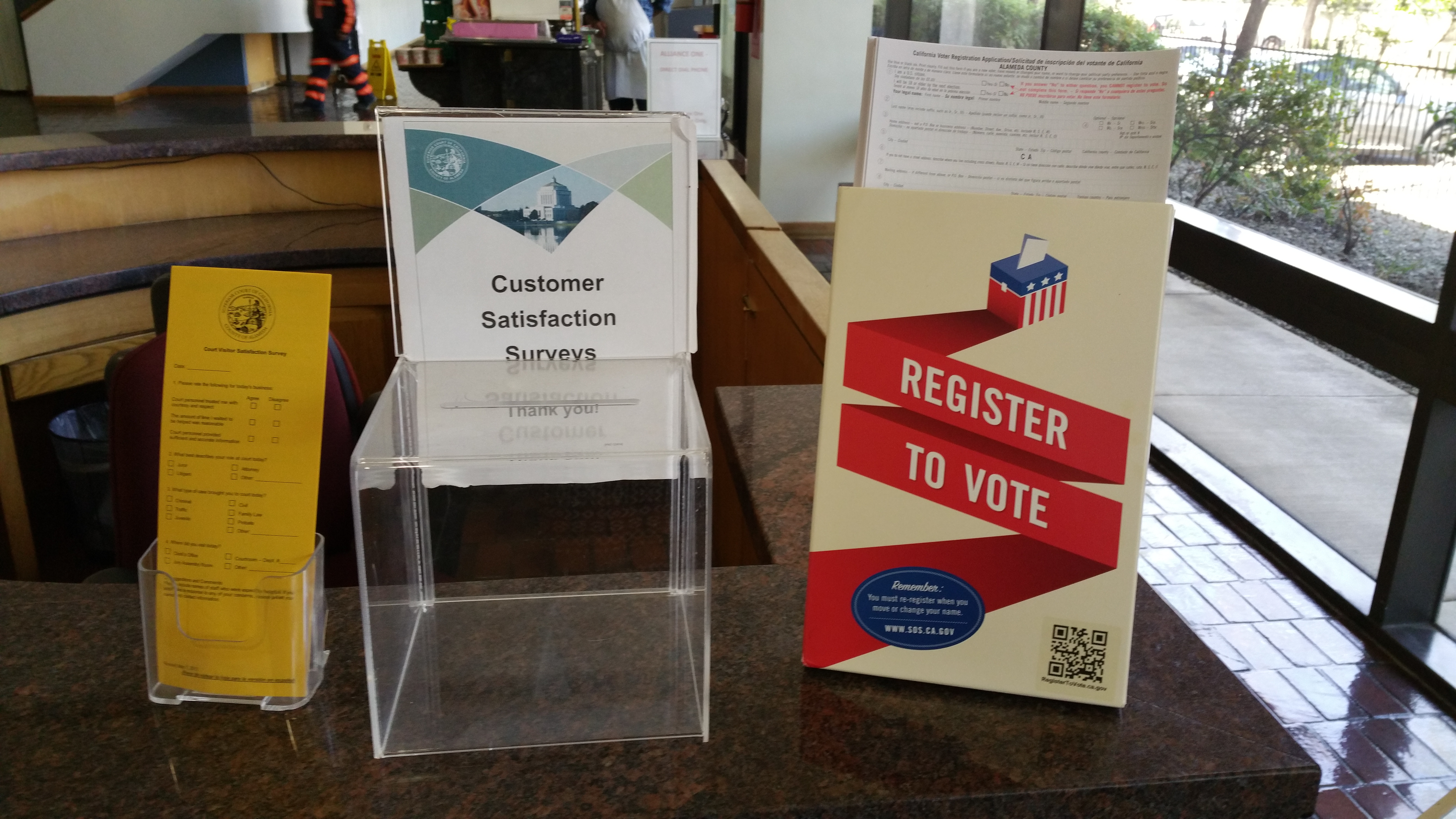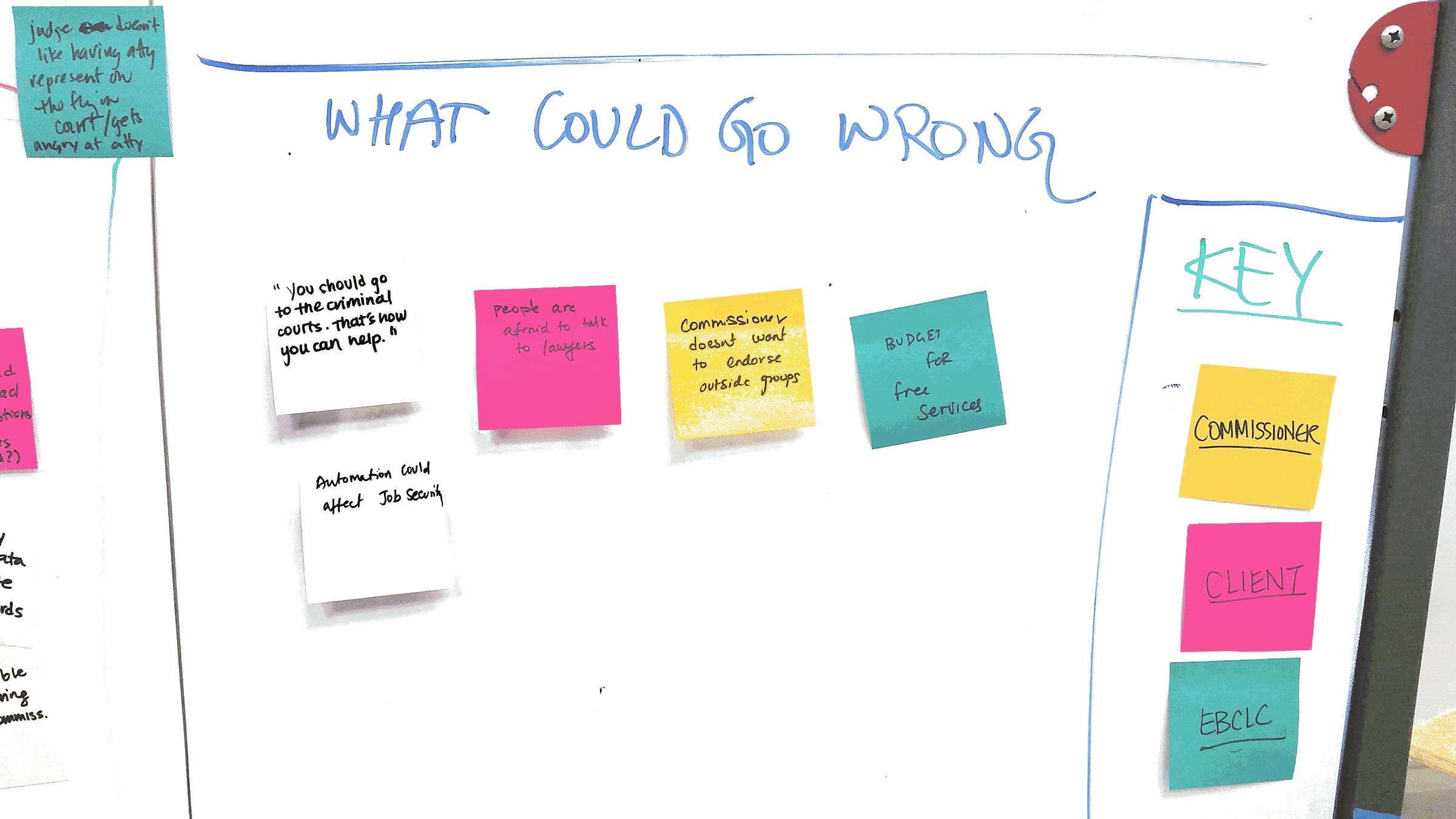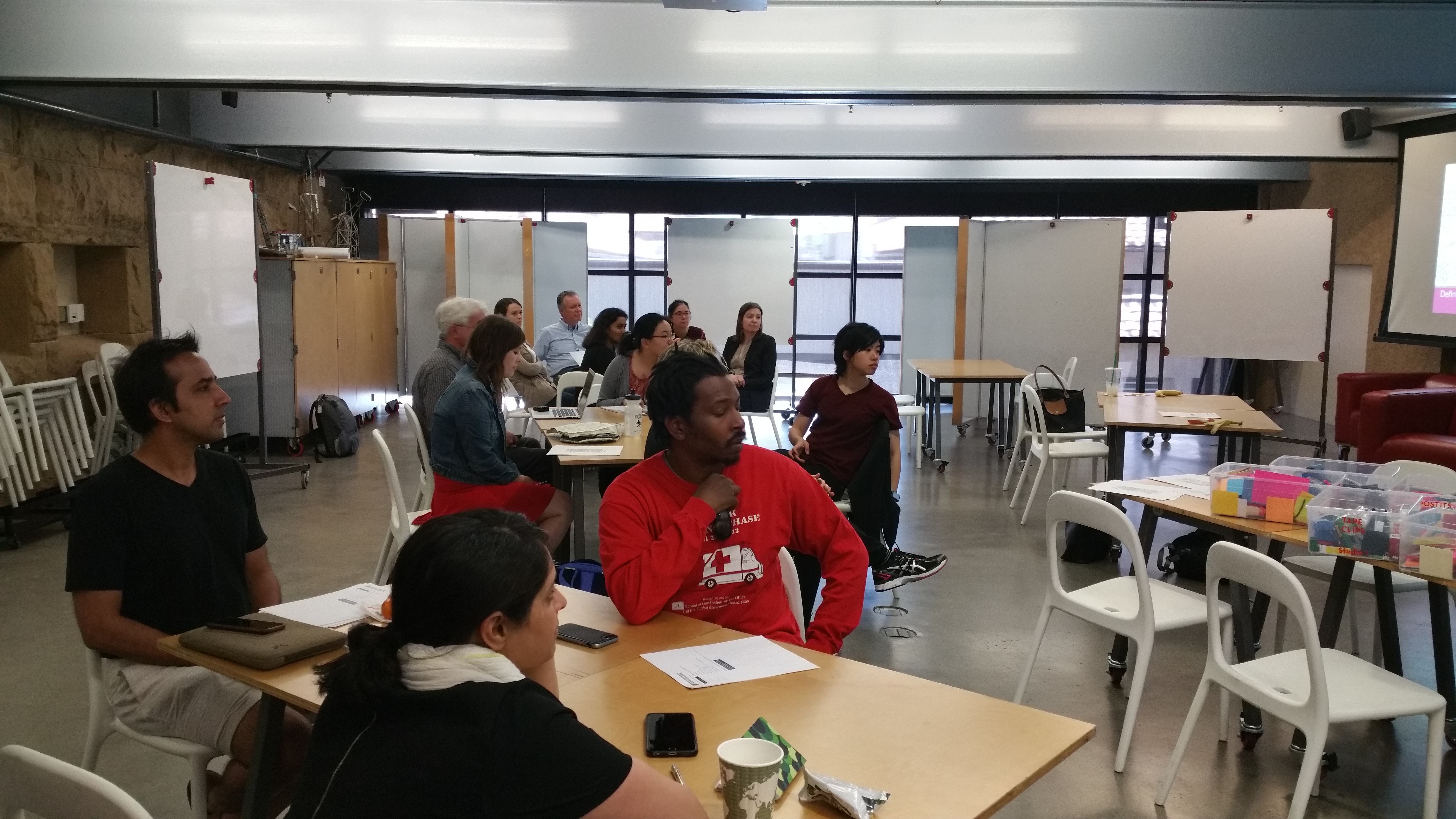Background
We are running the sprint in collaboration with various legal partners, including the National Legal Aid and Defender Association (NLADA), the National Center for State Courts (NCSC), the East Bay Community Law Center (EBCLC), and the California Judicial Council.
Each of these groups have worked on analyzing how the money involved in people’s journey through the justice system — particularly regarding court fines, fees, and bail — have serious repercussions on the quality of justice people receive.
Our sprint’s plans
Building from these group’s observations and proposals, participants in the sprint will identify opportunities for making the justice system fairer and more user-friendly to those who use it, around fines, fees, and bail.
We work in small groups to scope and build new initiatives, that could then be piloted by our partners or others in the justice system. Each group began with a challenge brief that we have defined based on the highest needs and biggest opportunities. Read our report of this first sprint.
Thurs. April 27, 5:30-7:30 (at dschool: Intros, Overview of Partners’ suggested design briefs, Review of current proposals, Team Formation)
Fri. April 28, 9:30am – 2pm (field trip on site in courts in Oakland: Research, Observe, Interview, Scout)
Sat., April 29, 11am-4pm (Synthesis and Prototyping lab at dschool)
Then, in May we will have a second sprint that will focus on testing, refinement, and final proposals back to our partners.
Our work will focus on three challenges — one centered on empowering people directly with rights and strategies, another on making courts more fair and efficient when assessing people’s ability to pay fines, and third about coordinating providers’ ability to serve people.
See our May-June testing sessions and findings here.
Challenge 1: Empowerment of People in the System
How do we help a person who is facing a misdemeanor or ticket (like a traffic ticket), but doesn’t automatically have a free lawyer (because they aren’t facing jail time), to better protect their own rights when dealing with the court?
This challenge grows out of the problem defendants have in protecting their own rights when representing themselves. They don’t know how to invoke their right to a hearing, in order to get their situation reviewed by a judge. They don’t know that they could possibly get a free lawyer to represent them, especially when they face punishment or loss of liberty because of outstanding fines.
We will design new ways to make individuals who are unrepresented to be strategic, aware, and empowered.
More resources:
- The Department of Justice report that documents their investigation into how local municipal courts use fines and fees to build revenue rather than for public safety, with disproportionate impact on poor people and African-Americans.
- The DOJ “Dear Colleague” letter that explains to courts what practices they should be following regarding fines and fees, to better comply with due process, equal protection, and sound public policy
Challenge 2: Smarter Assessments by the Court
How do we help courts make more efficient and fair assessments of people’s ability to pay fines in cases like traffic tickets, so that they do not overburden people with debt, interest, and imprisonment?
Currently, most courts do not take into account an individuals’ circumstances when assessing fines — and this can have a destructive impact on low-income people. When a person gets a traffic ticket and has to pay money to the courts to resolve it, how can we help the judge and the court make a better determination of whether the person can truly pay it?
If we had a smarter tool to judge whether a person is able to pay traffic tickets, we might be able to stop these initial fines from compounding into larger debts and other penalties.
Here are some possible resources:
- Hackathon projects from the NCSC’s CourtHack that propose solutions to the ability-to-pay problem
- The Price of Justice grants, distributed by the DOJ, that is supporting five projects across the states to improve courts’ practices regarding fines and fees, in California, Louisiana, Texas, Missouri, and Washington State
- The Judicial Council report on rule 4.335, and Calfornia rules of court that change how fines and fees are treated (Rule 4.106 on ability to modify payments for failures to appear/pay)
- The Matterhorn Online Case Resolution system in Michigan by Court Innovations.
- The DOJ press release about Washington State’s grant for building an ability-to-pay calculator and payment scheduler tool as part of the Price of Justice grant
- Ability to Pay Checklists and screeners from Michigan’s Ability to Pay working group, along with “Means Tests” to calculate a person’s ability to pay; and Payment Plan Calculators
- The National Center for State Courts has CourTools to have courts evaluate their own practices, including Legal Financial Obligations: Court Practices Survey, the Management of Legal Financial Obligations, and Ensuring Fairness in LFOs
Challenge 3: Holistic System Support
How do we connect defense organizations with civil legal aid organizations, to help people overcome procedural barriers and provide holistic support to clients that cross criminal/civil lines?
The legal (and legal aid) systems are divided along this split between civil and criminal law, but people’s lives are not. A person’s civil legal problems can spiral into criminal legal ones (with unpaid fines in some cases leading to imprisonment or other criminal punishments). In many other cases, people are dealing simultaneously with issues in civil and criminal courts, but they don’t have services that help them deal with the issues holistically.
In this ambitious, systems-level challenge, we will design an intervention that could improve the ability of providers to work across these arbitrary divisions and provide more coordinated, intelligent support to people who are in the legal system.
- a Webinar from NLADA that explains how fines and fees are used inequitably, and what strategies legal aid groups can use to protect people.
Our Design Work
A report from our ongoing project on Traffic Court redesign.
This past week and weekend, we ran our first half of a 2-part intensive course, Design for Justice: Fines, Fees, and Bail after Ferguson. We are tackling the (now infamous) way courts charge people high, punishing amounts of money for traffic tickets and other small infractions — and how these charges spiral into huge debts, suspension of driver’s license, and possible imprisonment, loss of employment, and poverty.
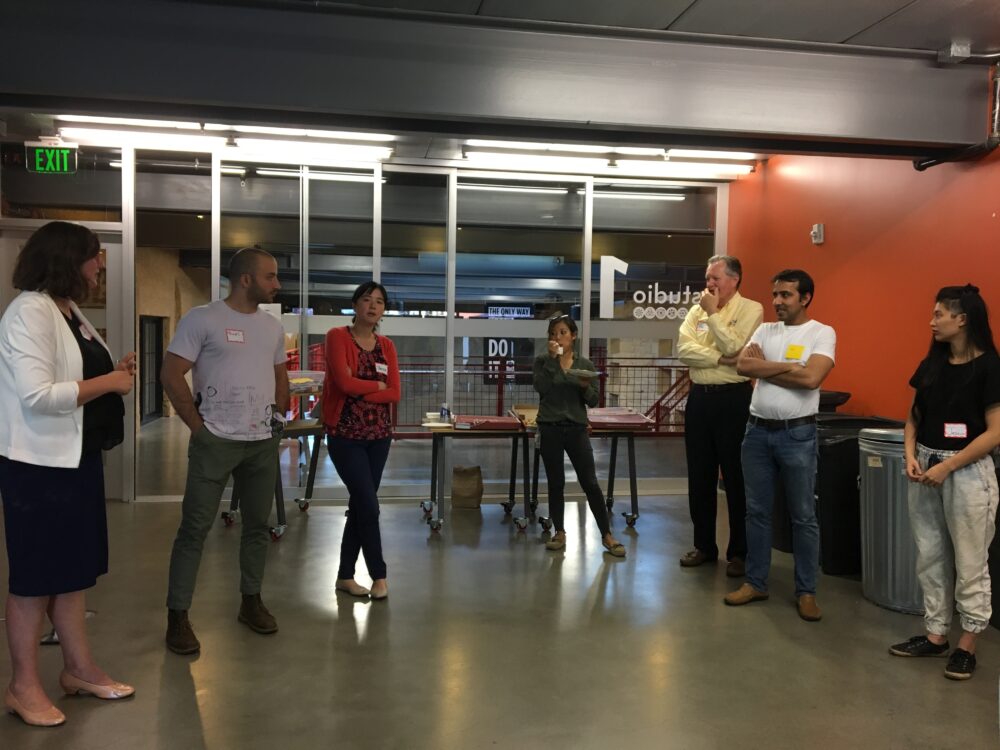
The class is taught with participating partners from the National Legal Aid and Defenders Association, the National Center for State Courts, the California Judicial Council, and the East Bay Community Legal Clinic.
Each of these stakeholders has an interest in reforming the way courts charge people money, and has some kind of work or task force that has recommended new rules, tools, and strategies to reform the system. In the class, we are taking their preliminary work, and applying a research-prototype-test design process to create some possible pilots for them.
Why this problem?
As courts and legislatures have steadily raised the amounts of fees, penalties, and surcharges required of people who have been given tickets, there is increasing scrutiny about these practices — and their implications for systemic poverty, racism, and access to justice.
Particularly after the Department of Justice’s report that covered court practices in Ferguson, Missouri, that resulted in high amounts of fines and fees targeting poor black people, there is growing momentum to reform this system. The DOJ pointed out how Ferguson municipal courts and law enforcement use fines and fees for the enrichment of the government at the expense of the people, especially poor and minority people.Since then, there have been more reports, task forces, and even a John Oliver piece on the problematic court fines and fees system. (See the materials below). Our class aimed to take the analysis and proposals coming out of this recent work, to then think about what can actually be built, launched, and tested to improve the system.
The Multi-Stakeholder, Partner-Student Approach of the Class
It was not a typical course, in that it integrated students and experts in equal participation. Rather than having external partners separated out, we had four different partner groups (each representing a different perspective and set of stakeholders in the challenge area) as part of our design work and teams.
We had students from the Law School, School of Education, Product Design, and Business School. We also had designers and innovation strategists from external companies like Google, SAP, YouTube, and the local NPR-affiliate KQED.
Unlike some of our other classes, the primary purpose of this type of course is not just educating students in the basics of the design process. Rather, we focused the class more on implementation, and building multi-stakeholder momentum around changing the broken system of fines and fees.
The Process We Used
We followed a design process, but with more research and curation of possible pathways before hand. The teaching team researched what the current proposals and solutions are, in order to help the participants figure out where there are gaps, things to build from, or otherwise.
We found four main categories of solution-types for court fines and fees: legal and court rule changes; new services; new tools; and better guidance regarding best practices and legality.
Better Guidance solution examples:
- Dear Colleague letter from DOJ to local courts, instructing them on what practices are unconstitutional
- Resource Center for courts, from National Task Force on Fines, Fees, and Bail
- Education via Webinars, conferences, commissions
New Rules, Legislation, and Policy solution examples:
- Reduce fees and fines
- Prevent taking away of driver’s license
- Prevent imprisonment for debts
- More oversight of municipal judges, collection of data, standardization of practices
New Services and Events solution examples:
- Driver’s License restoration day in Vermont
- California Traffic Amnesty Program
- Stand Down: dismissal of veterans’ court debt
- Community Service in place of fines
Smart Tools solution examples:
- Ability to pay calculators (CA, MI, WA, etc)
- Paper/digital Bench Cards to educate judges + court personnel
- Online traffic ticket resolution systems (Matterhorn in Michigan and Ohio)
- Self-assessment tools (NCSC CourTools)
- User presentation of inability to pay (CourtHack)
- User management of court process (CourtHack)
Our Challenge Briefs

We also worked with our partners to define 3 initial challenge briefs, to start directing the teams towards areas for improvement. These were still fairly broad, but focused in on particular stakeholder: the defendant, service providers, or the court.
We presented the problem area and the landscape in our initial meeting on Thursday evening, and then had our participants talk through what challenge they were most interested in, and what framings and questions they had to begin with. Small teams formed to do the field work the next day. And the experts were able to go in deep, with explanations about why the system is the way it is.
On our second day, we went to Alameda County’s Traffic Court, to observe the clinic that the EBCLC runs in a court room there, and then the traffic court that is held later in the morning. Our team interviewed and observed the many different people involved — the defendants, lawyers, paralegals, clerks, commissioners, info desk staffers, and more. We watched the full session of court, and then also got in-depth debriefs with various people — who walked through what they observed and what they thought we should work on.
In addition, we had a CEO of a California county court system come explain the entire system of how fines and fees work in California — including how the amounts got raised so high, where all the money goes, and why it is so hard to get the system changed (hint: it means taking money away from existing government agencies, who want court fines and fees revenue for their budget).
On the third day of the sprint, we came together to do more traditional design lab work — debriefing from our discovery work, choosing a specific opportunity or person’s need to focus on, and then creating quick prototypes to share and vet with each other.
After this sprint, we spent the next month working to refine the prototypes, so that we can test them later in May. We then ran a parallel sprint at the end of the month, in which we test and refine the concepts that emerged in the first round.
Concepts that emerged
1. Interactive Ability Pay Process
This prototype is aimed toward the courts and the judiciary, who are currently having to grapple with rules changes that allow any person, anywhere in the process of dealing with fines and fees, to request an “Ability to Pay’ assessment. For the first time in California, a defendant in traffic court can ask a commissioner, a clerk, a collections agency, or any other representative of the system for a reduction based on their financial situation.
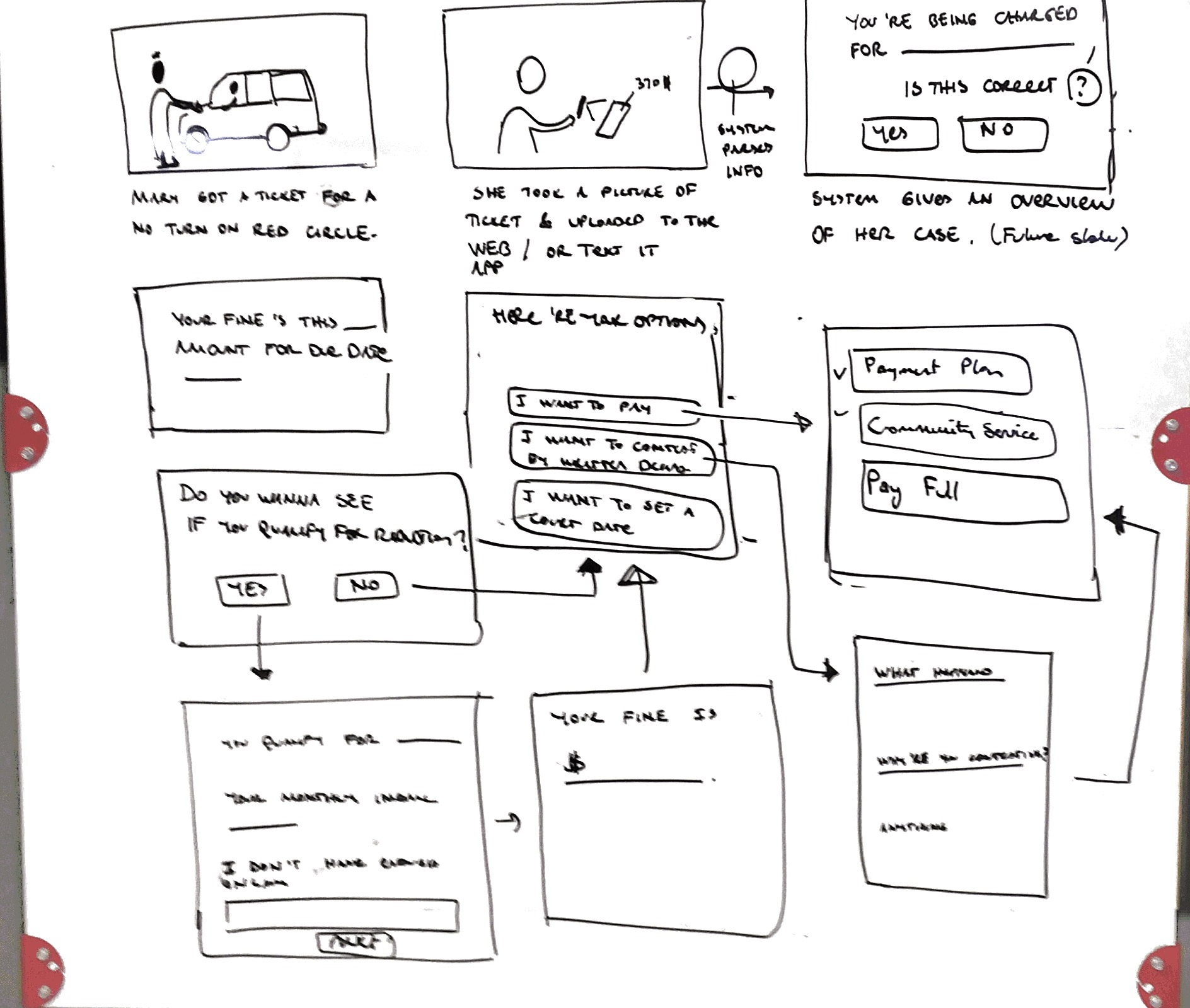
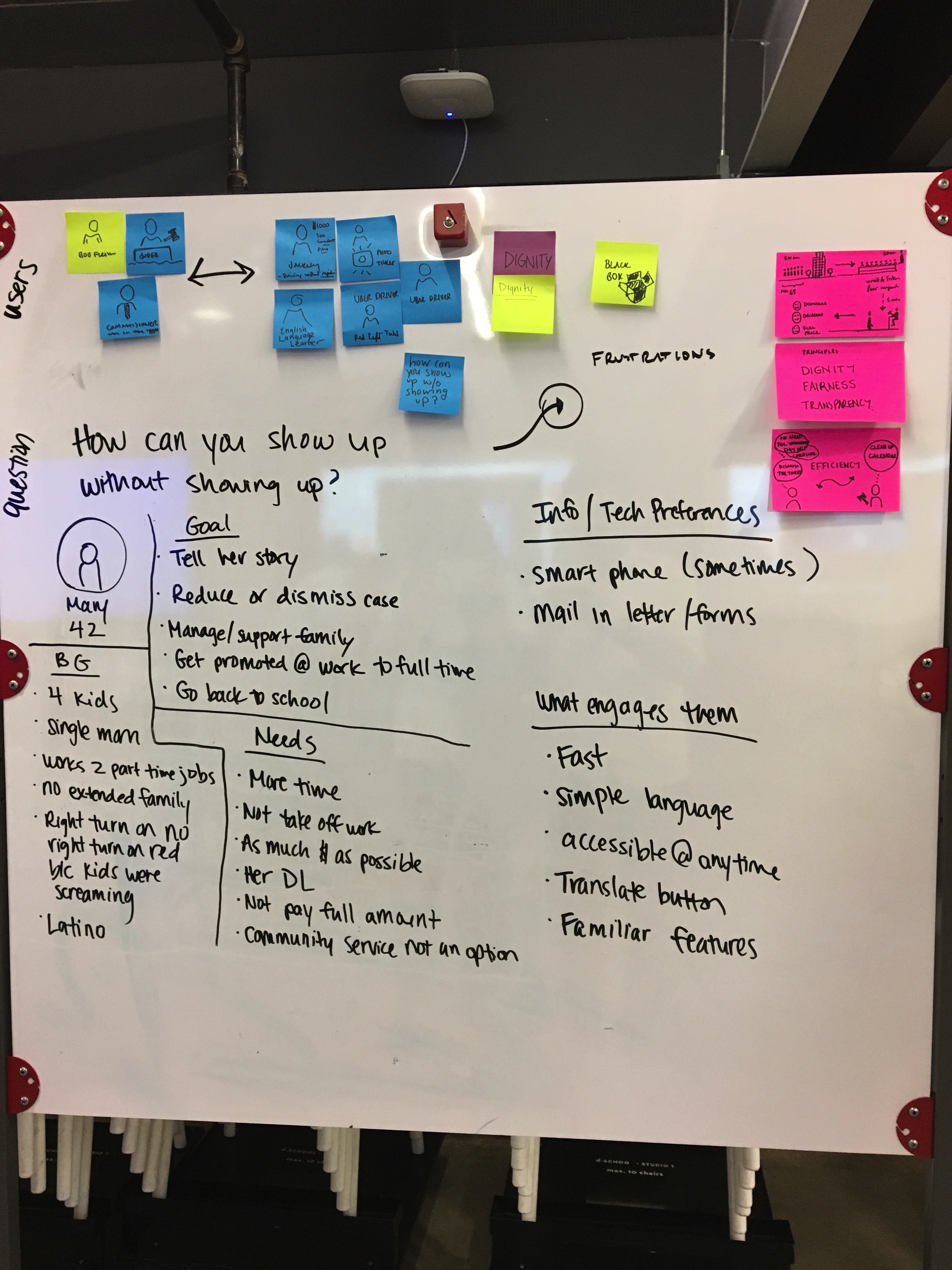
How courts will implement this process isn’t totally set yet — from (1) how people can get this request for an Ability to Pay assessment made, (2) what steps, forms, and hearings they’ll have to do, and (3) how they’ll be able to present proof, documents, and other evidence to support their financial situation.
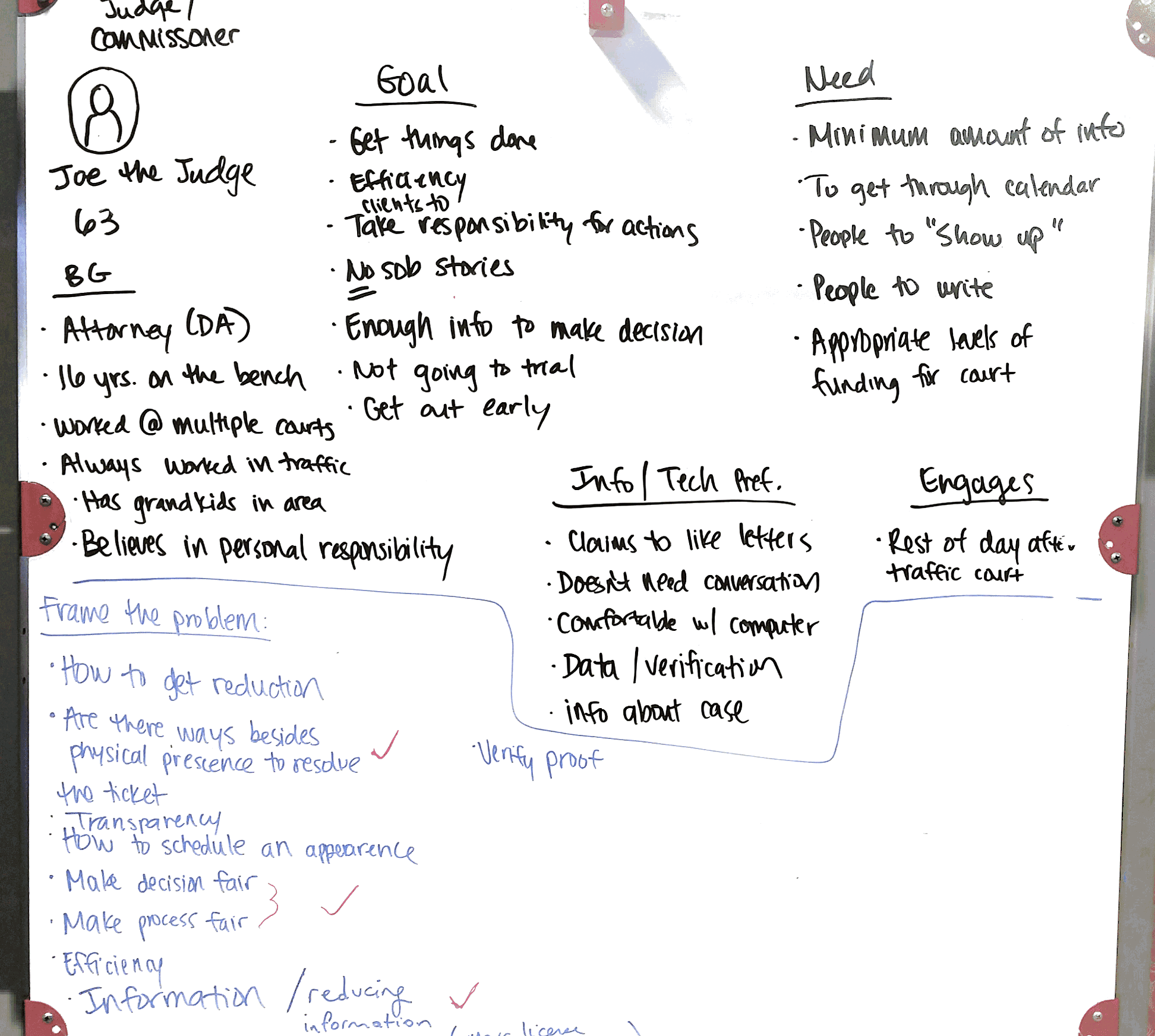

One group is prototyping a user-centered tool and process for Ability to Pay requests — hoping to define a model that California courts (or beyond) might adapt to they local jurisdiction. As the court rule changes, this is a ripe time for guidance about this new process can be rolled out so that it is intuitive, supportive, and empowering for defendants.
2. Immediate Ticket Resolution tool
Another prototype proposed was a way for a person to more immediately deal with a ticket — so that they would not have to deal with it later, and then possibly get punished if they forgot about the court hearing or other deadline. It would be a way to interact straight with the ticket, and then automatically either write a letter (so as to get their arguments or negotiation done in paper, without having to go to court), pay the fine, or otherwise take action.
The idea is that the lag in-between getting a ticket and then dealing with it is part of the problem that results in failures to appear and all the penalties and harm that arise from it. If we can get immediate action, at the moment of the ticketing, then we can help people move on and avoid processes that seem built for them to fail.
3. Guide Blast
A third concept was to create a set of guides for defendants, that could lay out options, process, and best practices for them. The goal is to create content, visuals, and other assets that can be adapted to multiple formats and stakeholders.
For example, we might create business cards with key essential right information and magic words to say. Then we might make brochures with more details about what to expect and how to be strategic. We can make them large maps as well, to hang up in courts or other community centers. Finally, we’d make them available digitally, whether through a website, text, or an app.
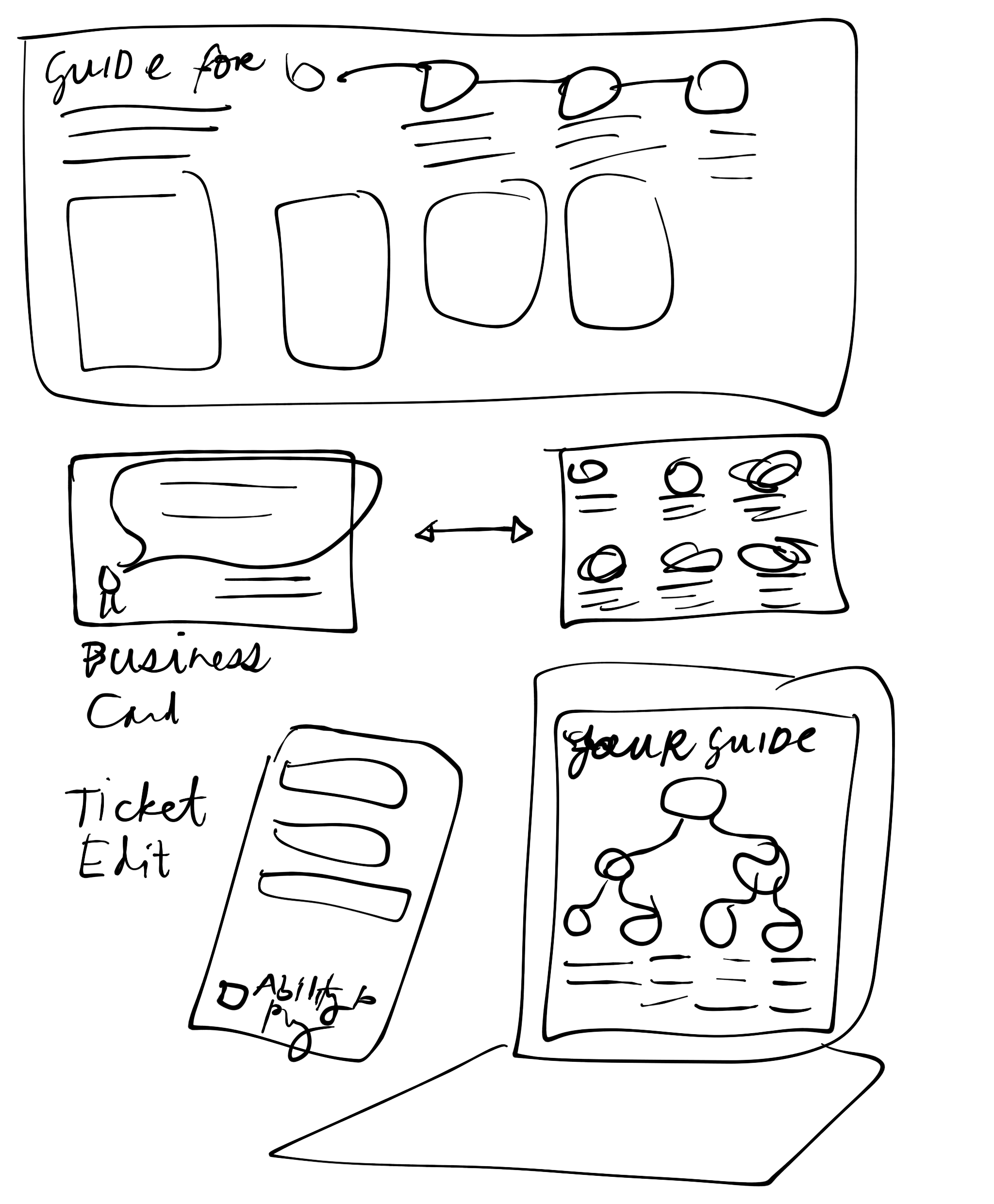
An advocacy group’s version of the guides would have more strategy, a court’s version of it would be more a straight representation of the process. We would make the templates and basic content, with the eye for customization. But we hope this is a common point of action for both courts and advocates — all of them are interested in more prepped defendants.
These guides would be educational and empowering. They would give transparency about what to expect, and a sense of how best to behave to make sure they don’t end up in bad situations (like with failure to appear, failure to pay, or not taking full advantage of the new rule changes around Ability to Pay).
4. Community Service Simplified System
The final proposal took on a particular part of the court fines and fees system: the way in which people can avoid part of the fine by doing community service instead. Currently, the Alameda court uses a 3rd party provider to collect service opportunities, schedule them, and verify the completion of service work. This is often paper-based, particularly the verification of the work done, so it often ends up failing — and people don’t get the proper credit for work they have done, and must do it again.
The proposal here is for the court to create a digital strategy around tracking service done and verifying it. Rather than using paper, it could be done through electronic confirmations, straight into the case management system. This way, there would be less chance for paper to get lost or otherwise screw up people’s verification.

The system could also allow the person to see opportunities, schedule their work, and track their completion. They’d have transparency of the process, and more ability to get the work done.
Big takeaways
Aside from the specific prototypes we’ll be building, our class also came to some larger conclusions and insights about the system and how to change it.
Procurement has social justice implications — need for better 3rd party vendors
How courts work with 3rd party providers is dysfunctional. These providers fail to provide prompt, transparent access to information about cases, fines, and methods to resolve them. For example, once a court transfers a fine/fee to Alliance One for collection, the public and lawyers are unable to see any information about the status of this debt, how much it is, what is happening with it.
Second, these providers charge high fees to the end-user, the customers, that are out of line with the action being performed.
For example, to sign up for a payment plan (because you are unable to pay) you have to pay a fee. To sign up to do community service (because you are unable to pay) you have to pay a fee. To pay with a credit card, you have to pay an enormously high fee.
The contracts that the court strikes with these providers do not make enough demands of them, to provide efficient, transparent, and affordable services. Those managing procurement and vendor relationships should follow key, value-based principles as government servants. Primarily, procurement contracts should follow key values: to protect people’s dignity, to give them transparent, instant access to their case information, and to combat poverty rather than exacerbate it.
The Tension between Equity and Efficiency
Most people in the system just want their case to be over. It is similar to the wider criminal justice system, and what leads to people pleading guilty just to have the process be over. People came to traffic court just wanting to pay as least as possible and get out. The judge wants to keep her calendar tight and be over with it.
Judicial Empathy and Representativeness
Another theme was the need for culture shifts in courts, that treat people with greater dignity, and with less of a ‘blame and scold’ attitude. The paternalistic approach, of “why people can’t get their lives together to come to court and make payments perpetuates a system that is unjust and exacerbates poverty, particularly along racial lines. Some of the concepts discussed were around culture-change modules, that would change how judges are selected (to be more representative of the community they are serving) — or in training them in empathy and personal understandings of the people they are serving.
Shock the System vs. Patch the System
A final theme (if not the most pronounced tension) of the class was what magnitude of prototype to pursue. If we conclude that the system of court fines and fees, paid by poor minorities to fund the government (rather than taxes or other revenue) is unfair — should our work be focused on fundamentally dismantling this system, or should it be focused on making it better for defendants in the near term? Meaning, should we be building prototypes to shock and explode the system, or to help people get through the existing system a little better?
This tension certainly has not been resolved in our class, but at least we were conscious of it — in part thanks to our various partners, who take different stances on this question. We noticed that the design sprint lends itself to the ‘patching the system’ approach, because these types of interventions seem more ‘prototype’able. They are easier to envision, plot out, and scope down. Larger ‘fundamentally change the system’ prototypes are about complex policies, law suits, culture changes, and incentive structures. Those types of interventions do not lend themselves to easy prototyping — but that is what we are trying to figure out. What kinds of design methods and models can we be using to prototype these?
Please find more documentation of our prototypes, findings, and possible pilots from the second half of our sprint!
General Resources
Watch John Oliver’s Last Week Tonight report on how municipalities’ court fines and fees for small infractions (like traffic tickets or petty crimes) spiral into debt, loss of driver’s license, loss of cars and homes, and imprisonment.
From the court’s perspective, there is a 2017 presentation from NACM (the National Center for Court Management) that summarizes the National Task Force on Fines, Fees, and Bail.
- A proposed bill in Massachusetts that would allow defendants who can’t pay court fees to do community service instead
- A proposed measure in Mississippi that would get rid of ‘debtors prisons’, where communities put in jail people who can’t afford to pay misdemeanor fines like traffic tickets
- The fight in Maryland over a pro-bail bill, that would have reestablished the option for judges to set bail even for poor defendants
- A study in New Orleans that shows effect of bail, fines and fees on low-income residents
- Proposed legislation in Illinois that would overhaul criminal court fees, standardizing fees across the states and to reduce the amount people are expected to pay
- An op-ed about proposed changes in California about taking away driver’s licenses as a penalty for Failure to Appear in Traffic court, or Failure to Pay traffic tickets
- A related article by EBCLC staff in the Orange County Register, “Traffic amnesty program highlights the problem of temporary solutions to systemic poverty and racial bias”
- The DOJ’s OJP Diagnostic Center has published a Resource Guide: Reforming the Assessment and Enforcement of Fines and Fees. It includes links to an array of backgrounders that provide summaries of issues; case studies; issue studies; reform guidance; and reform tools.
- Best Practice Recommendations for Missouri Municipal Courts, from the NCSC and State Justice Institute, November 2015, that recommends that municipal courts not be revenue generators, and that bail not be used to enrich municipal treasuries. It also says that community service opportunities should be recommended in lieu of fines
- Michigan’s ability to pay workgroup has published possible statutory amendments to be made to local law to improve the situation regarding fines and fees; as well as court rule amendments to be made
The National Center for State Courts has an interactive visual to let you explore states’ different practices on fines, fees, and bail:
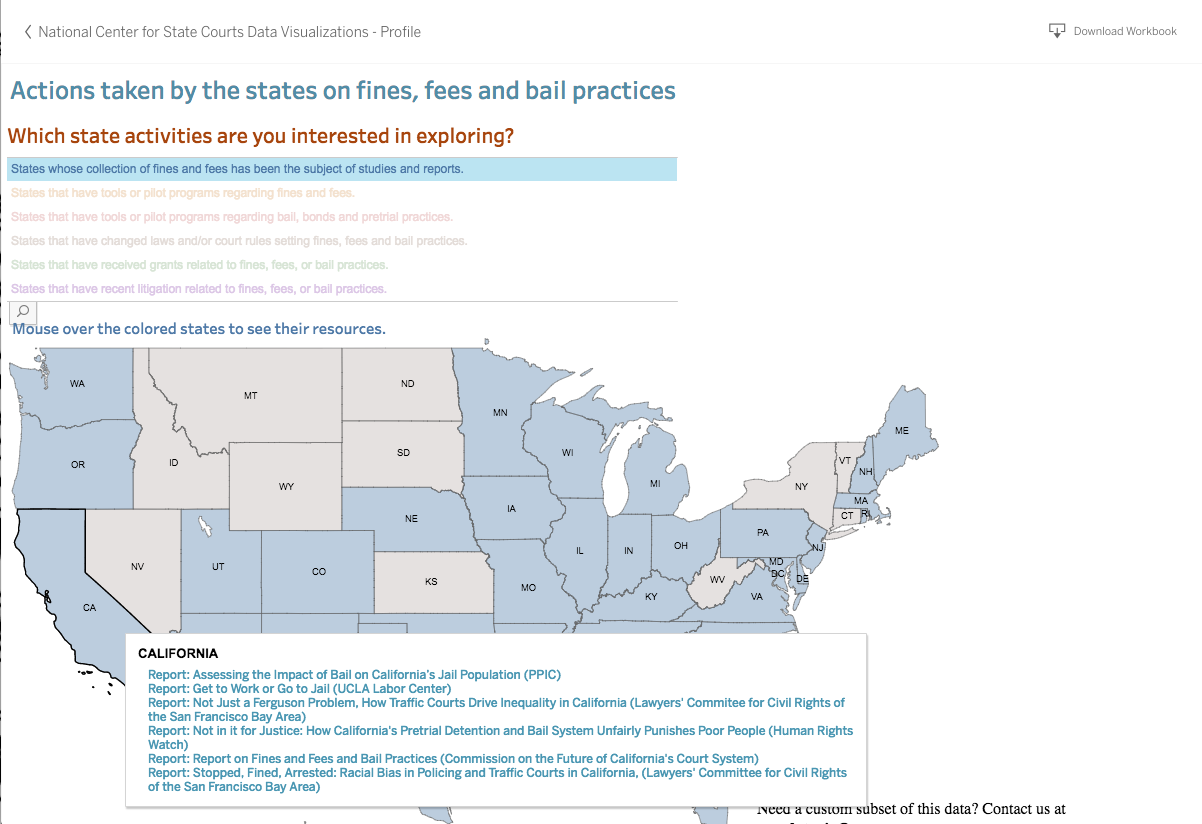
Harvard Law School’s Criminal Justice Policy Program has a Reform Builder tool that provides analytics on states and laws, to consider policy alternatives and see what the status quo is
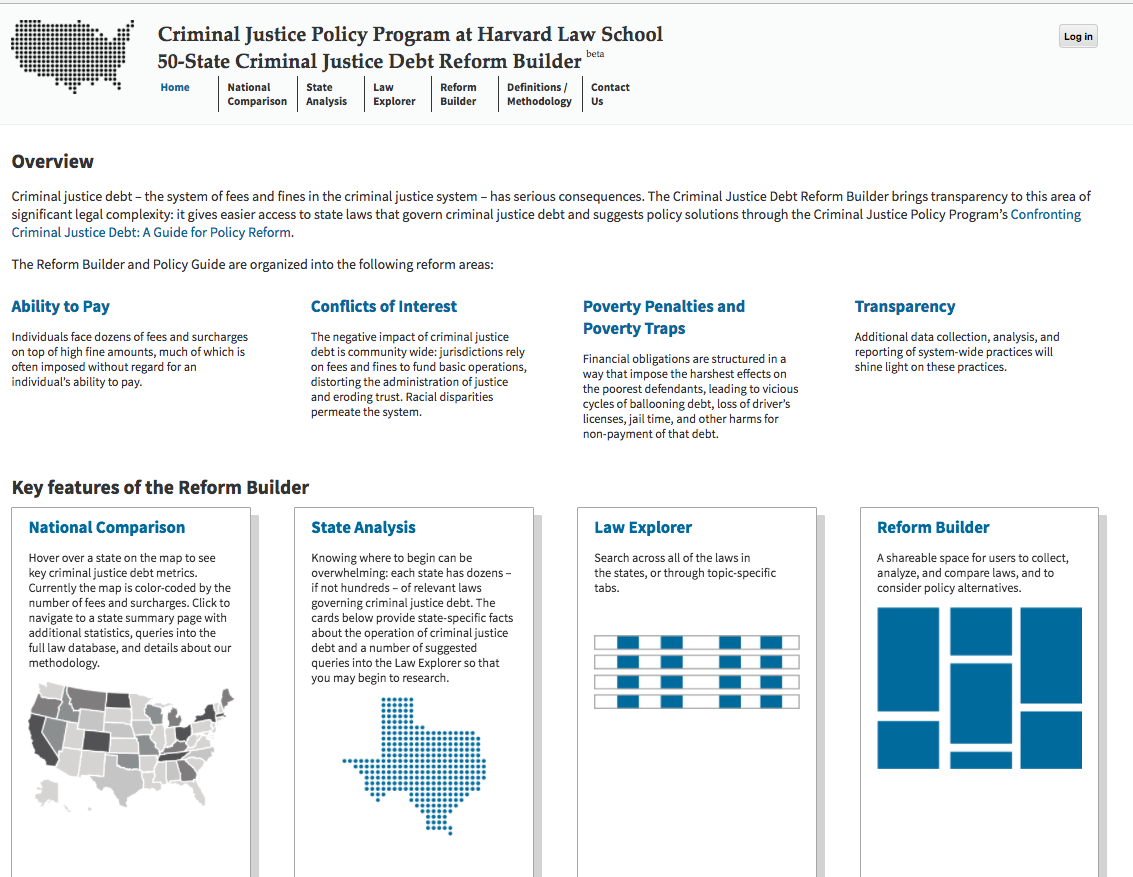
Stopped, Fined, and Arrested: Racial Bias in Policing and Traffic Courts in California, an April 2016 report from the EBCLC about the racial injustices that accompany traffic stops and tickets.
The ACLU has a 2010 report on the imprisonment of people for failing to pay legal debts, called In for a Penny: the Rise of America’s New Debtors’ Prisons, with particular focus on Louisiana, Michigan, Ohio, Georgia, and Washington State
The EBCLC has a side-by-side map that shows how many driver’s licenses have been suspended, as compared to the poverty rate in that area — to show the link between suspensions and poverty
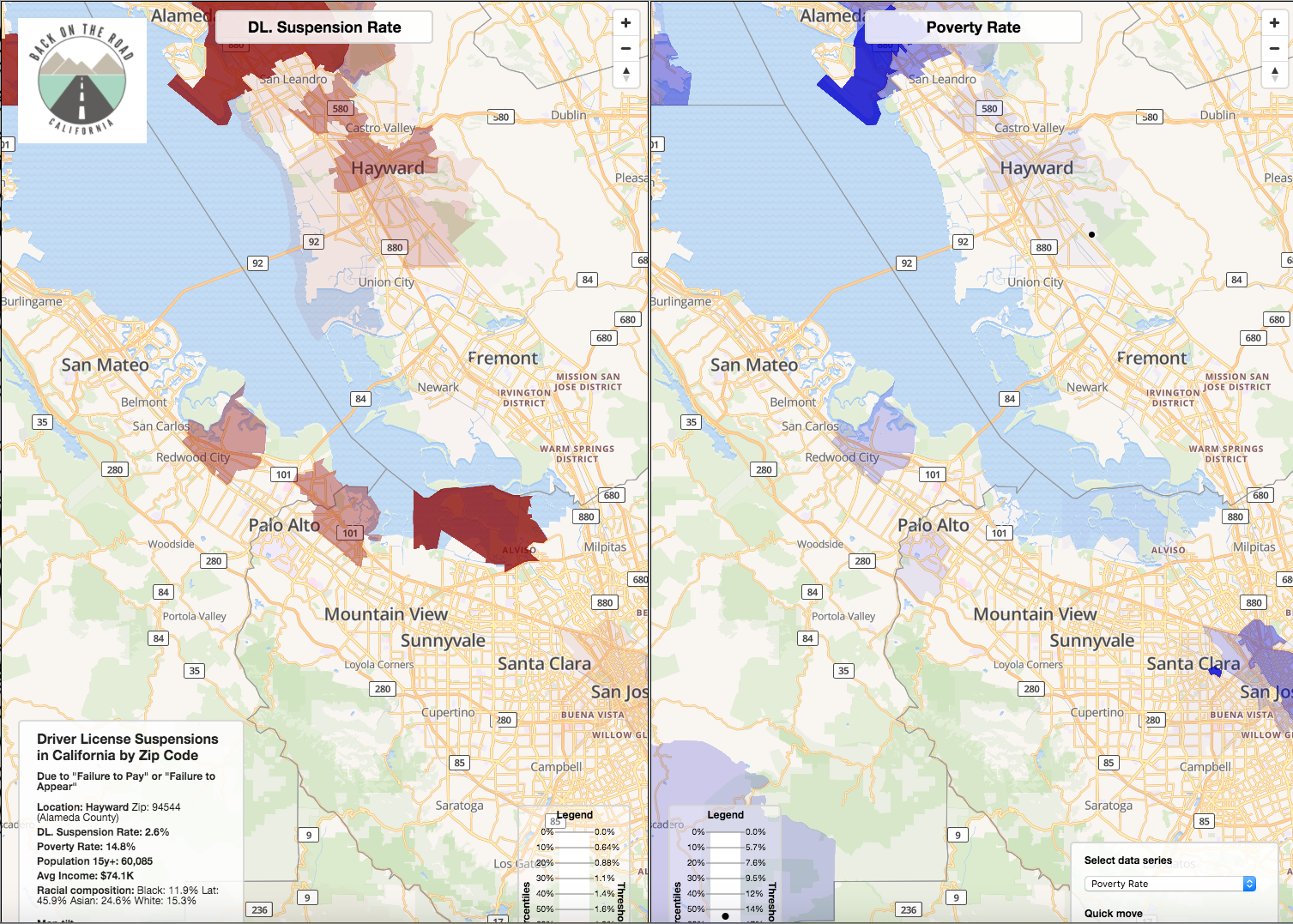
The Task Force on Fines, Fees, and Bail has collected international reports, from the UK, Australia, Scotland, and elsewhere to profile how other countries deal with fines, fees, and bail
Resources around Bail and Pretrial Release
Though we won’t take bail as one of the central issues of our sprint, there are many inter-related issues with bail and court fines and fees.
The Vera Institute of Justice presents a short video explanation of how the bail system and the fines and fees associated with it have major justice implications, especially for poor, black people
The Arnold Foundation has supported a Pretrial Risk Assessment Tool, the Public Safety Assessment to help judges assess a person’s likelihood of committing another crime or failing to appear at court, through the use of predictive data
The Pretrial Justice Institute has an initiative, Smart Pretrial, to assess the risk of pretrial release, collect best practices, and provide training and tech assistance to those interested in making better assessments.
KQED has reports on proposals to limit cash bail in California, to stop punishing poor people for being poor.
Human Rights Watch report, “Not Im It for the Justice” identifies the problems with California’s Pretrial Detention and Bail System, and the injustices it has on poor people who plead guilty to avoid detention.


See a video spotlighting some of the findings from the report:
Who are the key actors involved?
- The federal Department of Justice, which has a suite of resources, guides, and grants to support the reform of local fines and fees practices
- National Task Force on Fines, Fees, and Bail
- The American Civil Liberties Union (ACLU)
- Vera Institute for Justice
- East Bay Community Law Center
- Conference of Chief Justices
- The Brennan Center for Justice at New York University School of Law, has a Criminal Justice Debt program that looks into how to address injustices regarding criminal justices fines and fees
- Laura and John Arnold Foundation has been providing grant support for initiatives in this area
- State Justice Institute also provides grants in this area
- The Council of State Governments Justice Center has resources on Legal Financial Obligations, and a Repaying Debts guide
What will we build?
We will not specify the exact thing to be built during our sprint, though our partners and research will point to specific ideas that could be built out.
We also encourage a mix of projects that will focus on front-end experiences of litigants and defendants, as well as back-end, systems level changes.

